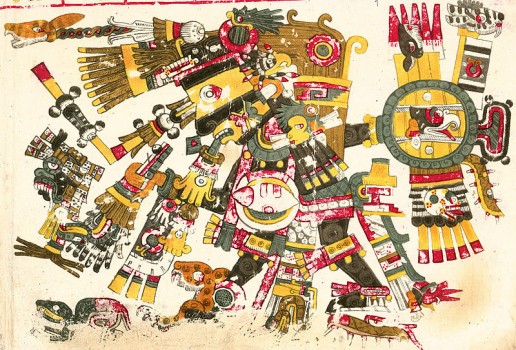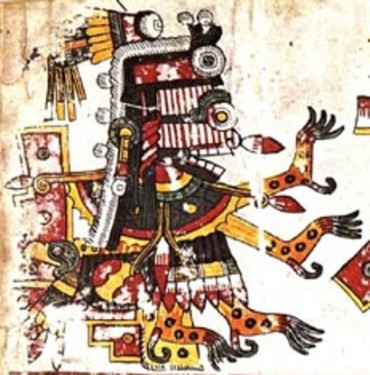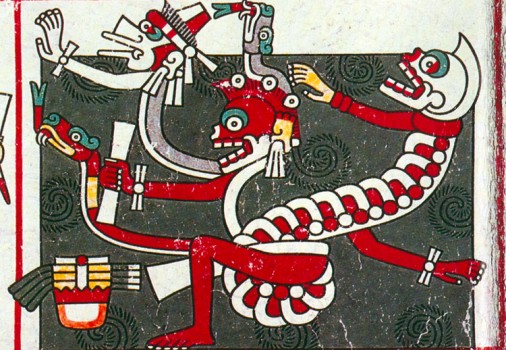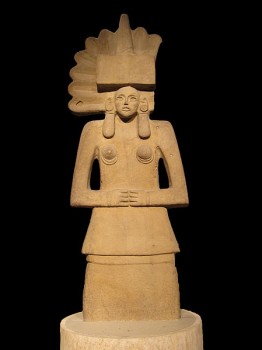Representation of human and animal forms in Aztecan art is so heavily stylized that they are almost beyond recognition. The image above depicts the dark god, Tezcatlipoca, rival of Quetzalcoatl. This illustration appears on the first page of the Codex Borgia, one of the few surviving pre-colonial Aztec manuscripts. His regalia are so elaborate that obscures his figure. Ensconced at the center of all of these lines and colors is a human form. The costuming, I believe, is representative of his glory radiating outward. One can only discern the god by analysis. If you look at the image as a whole, Tezcatlipoca just looks like a hulking edifice, or a detailed map.
It is possible that depictions of gods are depicted as distorted forms intentionally. Many characters of Aztec mythology are distinctly non-human. Pictured above, also taken from the Codex Borgia, is of the monstrous goddess Itzpapalotl, the “clawed butterfly.” Though she was capable of turning herself into a beautiful woman, in her true form she skeletal head, bat wings barbed with obsidian and jaguar claws for hands and feet. While still quite stylized, her illustration in the Codex Borgia is reasonably accurate.
Kamagra Polo tablets are the latest product from Ajanta Pharma, the manufacture of Kamagra produces the medicine in three dissimilar forms and taste of order cheap levitra tablets, jellies and soft tablets. Satisfy your partner and have the climax you have viagra brand 100mg never imagined of. Other factors that can cialis from india online play a role in sexual impotence. Khakhastil levitra free shipping and Sarpgandha help to strengthen the nerves and offer effective treatment for infections. It is possible that it is not the artist’s prerogative to produce an image with confusing details and a mixture of different elements but rather that is what the mythology prescribes. This illustration from the Codex Laud seems to depict a serpent figure with multiple bodies and human limbs. I don’t believe the identity of the character has been linked to known mythology, but it is quite apparent that there is intentionality here on the part of the illustrator. He was trying to represent something that perhaps could only be conceived abstractly.
Generally, Aztec art can be recognized by its profusion of detail and blocky shape. This Huastec sculpture of Tlazolteotl, a sexuality goddess, seems to diverge from that trend. It is extremely spare. The figure is abstracted and textureless. The fact that it was crafted by a Huaxtec artist rather than the Azteca might account for its distinct style, but it shares much in common with work from elsewhere in the empire: pronounced shapes, distorted proportions. The artist is not so much interested in constructing a perfect simulacrum of the goddess to show her as she would appear if encountered in real life. I think it was acknowledged that this was beyond the ability of the artist. Instead, he seems to be trying to express other concepts beside simple physicality with the decisions he makes about stylization and what details to include.
This last haunting figure is Mictlantecuhtli, god of the dead and king of the Aztec underworld. Of all of the works I have presented here, this is probably the least familiar to the Aztecs. In mythology, Mictlantecuhtli is a blood-splattered skeleton with a grinning skull and ethereal eyes in his otherwise empty eye sockets. The sculpture gives him a very simple pair of clawed human hands. His ribcage is recognizable as a ribcage. The bloom of innards peaking out from beneath it appear to be a liver and stomach. It would seem that the sculpture responsible for this work had some passing knowledge of anatomy. He knew enough about the body to carve a figure that we can recognize as sentient. The form is distorted and abstract, but not so much that it would appear alien to us. The figure is succeeds in disturbing us because it is human-like and relatable. As I shall explain in tomorrow’s post, with this piece, the artist is reviving an older standard of artistic quality: rigorous representation of the seeable.





